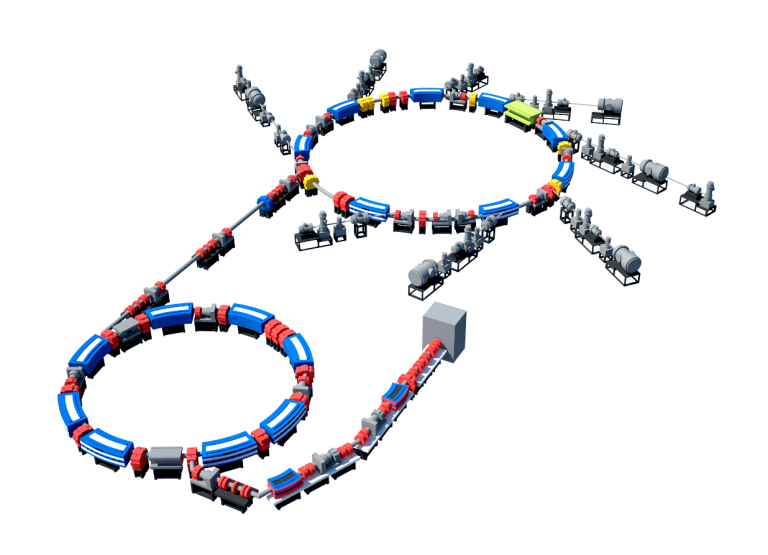SPL Tour
The tour of Siam Photon Laboratory (SPL Tour), will be on Saturday, June 18, 2022, after the scenes at Synchrotron Light Research Institute (SLRI), Nakhon Ratchasima. Tour participants will see how Siam Photon Laboratory plays an important role in supporting Thailand, ASEAN countries and countries in other regions with synchrotron application research.
We are happy to invite you to attend the SPL Tour as a part of the IPAC ’22. Since numbers of tour participants are limited, early registration is recommended.
Where, when and how many:
Siam Photon Laboratory (SPL) is located at SLRI, Nakhon Ratchasima where is 252 kms. from Bangkok. The tour will take approximately 9 hours (round-trip). The bus is scheduled to leave the conference venue at 7:30 a.m. with an anticipated arriving time around 5:30 p.m. at the IMPACT, Nonthaburi.
The tour can allocate only 150 slots and they will be on the first-come, first-served basis.
| Date: | Saturday, June 18, 2022 |
| Where: | Siam Photon Laboratory, Synchrotron Light Research Institute (Public Organization), Nakhon Ratchasima Province |
| Time: | 11.30 a.m. – 2.30 p.m. 30 minutes for SLRI Overview and 1.30 hrs. for SPL Tour |
| The cost for the tour: | 1,500 Baht The tour fee includes round-trip transportation by bus, 2 refreshments, and lunch |
| Dress: | Casual dress with comfortable shoes. (Sandal or slipper is not recommended. |
| Break and Lunch: | • 2 refreshments will be served in a bus during travelling. • Lunch will be arranged at SLRI at 12.00. |
| Travel: | By air-conditioned bus |
How:
Registration for SPL Tour will be opened on Friday November 12, 2021
All guests mush review safety information before attending the tour.
How much:
The fee for tour is 1,500 Baht (VAT included).
Important information:
Siam Photon Laboratory
Siam Photon Laboratory is the 1.2 GeV electron storage ring, serving more than 500 projects each year on its 12 beamlines. Operating for users since 2003, SPL is the first synchrotron light source in Thailand and providing synchrotron radiation and total solutions for users from academic and industrial sectors. We are the ASEAN’s leader in synchrotron science supporting food, agricultural, and industrial development.
As the host of the IPAC ’22, we are proud to offer a behind-the-scenes look at SPL facilities. IPAC delegates will have unprecedented access to the accelerator and a chance to see firsthand some of the amazing research being done.
The Siam Photon Project was approved by the government of Thailand in 1996 to develop the Siam Photon Source (SPS), the first synchrotron light source in Thailand. Major parts of the source were transferred from the shutdown SORTEC laboratory in Japan. The storage ring was redesigned for 1.2 GeV operation. The Project was continuously managed by the National Synchrotron Research Center (NSRC) which was established under the resolution of the Cabinet of the Thai Government met on 5 March 1996. At that time, the Cabinet agreed on the establishment of the NSRC Project under supervision of the Ministry of Science, Technology and Environment. The project aimed at promoting basic and applied scientific research in Thailand. The NSRC was located at the Technopolis of Suranaree University of Technology in Nakhon Ratchasima. Later, the Synchrotron Light Research Institute (SLRI) was established to replace the NSRC.
Synchrotron Radiation Generation
Synchrotron radiation facility, or synchrotron light source, produces synchrotron light by accelerating charged particles, mostly electrons due to their light weight, thus making it easier to accelerate, to nearly the speed of light. These relativistic electrons are then deflected by a magnetic field, causing them to lose some of their energy in the form of an electromagnetic wave, i.e. synchrotron light, in the direction tangential to their orbit. The generated light is then transported to an experimental station via a photon beamline.

Components of the Siam Photon Source
1. Electron gun
Electron beam is produced by the electron gun via thermionic process, that is, the gun filament is heated by the applied electric current causing electrons to be released. These electrons are then ‘pulled’ toward the linear accelerator by an applied electric field.
2. Linear accelerators
Electron beam from the electron gun is then accelerated by two 20 MeV (20 million electron volts) linear accelerators, or linacs for short. After passing through the two accelerating structures, the 40 MeV electrons then enter the booster synchrotron via the low-energy beam transport line (LBT) for further acceleration.
3. Booster synchrotron
The booster synchrotron accelerates 40 MeV low energy electrons to 1.0 GeV (1 billion electron volts). Each round an electron circulates in the booster ring it gains incremental energy through applied radio wave inside the radio-frequency (RF) cavity. To attain 1.0 GeV energy electrons must circulate approximately 4 million turns in the booster, although the whole process lasts merely 0.6 seconds.
4. Storage ring
The 1.0 GeV electrons are then sent to the storage ring to be further accelerated up to 1.2 GeV. After this energy ramping process the electrons are stored in the ring to produce synchrotron radiation.
5. Insertion device
Insertion devices are specially designed magnetic systems installed or ‘inserted‘ into the electron storage ring to produce synchrotron radiation with specific properties. These magnets are able to generate synchrotron light with higher brightness, or higher energy, or both. They can also be designed to produce synchrotron light with specific polarization, i.e. circular or elliptical polarization.
6. Photon beamlines
Synchrotron light is carried to the experimental stations via photon beamlines. The two most important components of a photon beamline are the monochromator and focusing elements. Mirrors are used to focus the photon beam to a small area of interest while retaining the available photon fluxes. Monochromator is used to select the photon energy suitable for a particular experiment. Each beamline has different components and setups depending on the photon energy range to be used and type of experiment to be carried out.
7. Experimental stations
Experimental station is where the sample to be studied is located. A great number of measurements and experiments can be set up to utilize the generated synchrotron radiation. Data from the interaction processes between light and matter is then collected for subsequent analyses. Measurement techniques utilizing synchrotron radiation have been proven to be invaluable in researches in a wide variety of disciplines, including physical science, biological science, materials science, agriculture, archaeology, environmental science, among others.
Beamline
BL1.1W: Multiple X-ray Techniques
Crystalline phase purity and compositions elemental analysis, chemical specification, and structural investigation of materials
BL1.2W: XTM X-ray Tomographic Microscopy
2D and 3D microscopy and imaging
BL1.3W: SAXS/WAXS Small Angle X-ray Scattering / Wide Angle X-ray Scattering
Nano-structural investigation of materials nanoparticle size and morphology
BL2.2: TRXAS Time-Resolved X-ray Absorption Spectroscopy
In-situ chemical and structural investigation of materials
BL3.2U: Photoemission Spectroscopy & Photoemission Electron Spectroscopy
Surface, interface, and thin-film research materials science
BL4.1: IR Infrared Spectroscopy
Biomedical and biological science environmental science
BL5.1: XAS ASEAN X-ray Absorption Spectroscopy
Chemical and structural investigation of materials (IAEA supports)
BL5.3: XPS X-ray Photoelectron Emission Spectroscopy
(SUT-NANOTEC-SLRI)
Surface, interface, and thin-film research materials science
BL5.2: XAS X-ray Absorption Spectroscopy
(SUT–NANOTEC–SLRI)
Chemical and structural investigation of materials
BL6: DXL Deep X-ray Lithography
Fabrication of high-aspect-ratio microstructures
BL7.2W: MX Micromolecular Crystallography
Structural investigation of proteins, enzymes and viruses
BL8: XAS X-ray Absorption Spectroscopy and Full-field X-ray Fluorescence Imaging
Chemical and structural investigation of materials, archaeology, environmental
